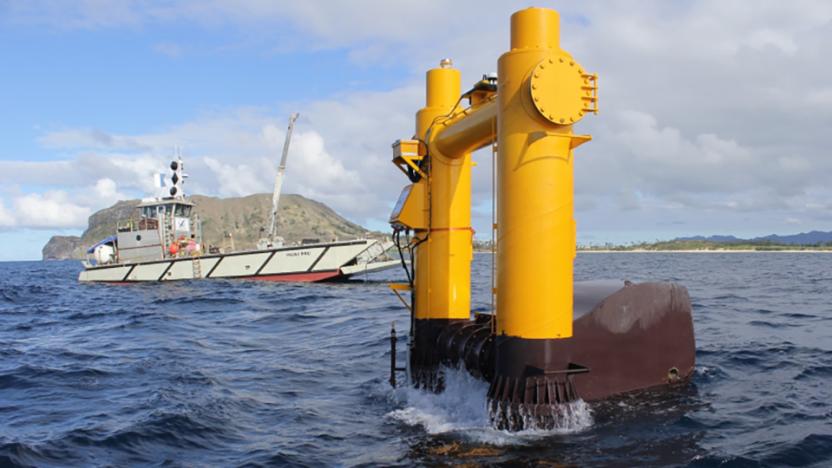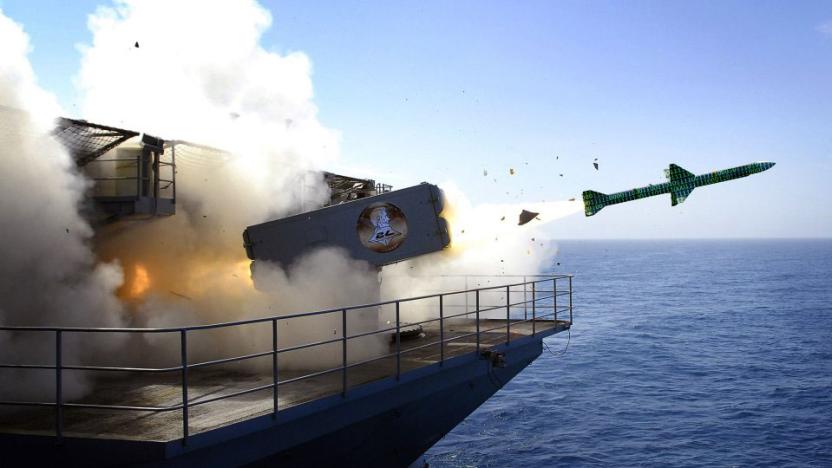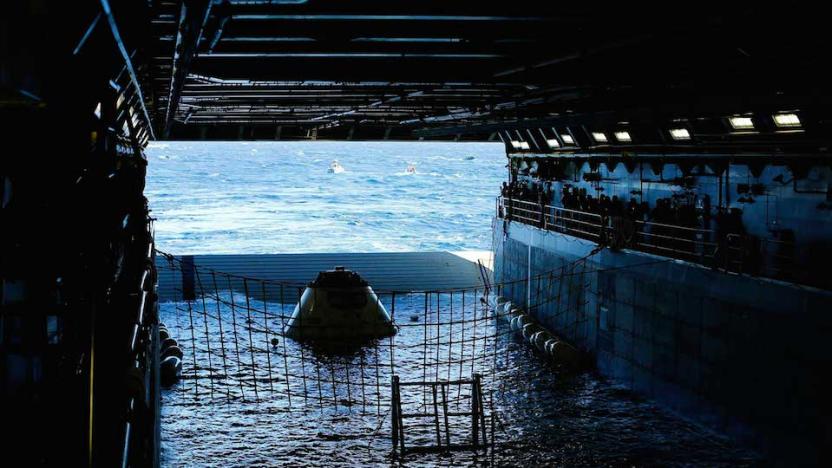US Navy
Latest

US Army and Navy unban Twitch commenter who criticized the military
The US Army and Navy have agreed to unban Jordan Uhl, the activist who linked to a Wikipedia page listing US military war crimes in their Twitch chats. After the incident, Uhl wrote an article criticizing the military for using Twitch to scout for potential recruits, especially since recruiters can interact with kids as young as 13. In a letter sent to Columbia University’s Knight First Amendment Institute, which represented Uhl, the Navy justified his ban by pointing out that he violated the channel’s spam policy when he kept posting similar messages over a period of three days.

Navy bans TikTok from government-issued phones
Don't expect to post often on TikTok if you're serving in the US Navy. The military branch has banned use of the social video app on any government-issued mobile devices. ByteDance's software is allegedly a "cybersecurity threat," according to a bulletin. The Navy's Lieutenant Colonel Uriah Orland didn't offer specific reasons for the ban, but the notice asked troops to take action to "safeguard their personal information."

US Navy will scrap touchscreen controls on its destroyers
The US military normally embraces technology whenever possible. This time, however, it's taking a conspicuous step back. The Navy will ditch touchscreens on destroyers within the next 18 to 24 months, reverting instead to conventional helm controls and physical throttles. The decision came in response to feedback from the fleet after an investigation into the USS John S. McCain's collision in 2017, which killed 10 Navy sailors. The report found that the warship's complex touchscreen interface and poor training played a role in the crash with a Liberian-flagged vessel.

US took down Iranian drone using new jammer technology
When the USS Boxer took down an Iranian drone in the Strait of Hormuz, it apparently represented a baptism by fire for new technology. The Wall Street Journal understands that the action was the US Navy's first use of MADIS (Marine Air Defense Integrated System), an anti-drone system adapted for the sea. The technology uses jammers to block a drone's communications and force it to crash. Some versions of MADIS can also fire at the drones, although it's not clear that was the case here.

Senators ask the FCC to limit 5G auction to protect weather forecasts
In March, the Federal Communications Commission (FCC) began auctioning blocks of the 24 GHz spectrum, which could be used to implement future 5G networks. Shortly afterward, the US Navy released a memo warning that 5G in the 24 GHz band could interfere with weather satellites. Now, Senators Ron Wyden (D-Ore.) and Maria Cantwell (D-Wash.) are urging the FCC not to allow wireless companies to operate 5G in that spectrum until weather forecasting operations are protected. The Senators wrote a letter to FCC Chairman Ajit Pai yesterday, citing the Navy's memo and accusing the FCC of ignoring "the serious alarms the scientific community is raising."

ICYMI: LOCUST launchers, VR crime scenes and more
try{document.getElementById("aol-cms-player-2").style.display="none";}catch(e){} Today on In Case You Missed It: The US Navy shows off a UAV launcher that fires drones like an overgrown T-shirt cannon. We take a look at two uses for virtual reality -- recreating crime scenes for jurors and Netflix's digital Blockbuster -- that might actually be useful. And a paralyzed father stood on mechanical legs to walk his daughter down the aisle.

Wave generator supplies US electrical grid for the first time
A prototype wave generator called Azura is supplying grid power to Hawaii, the first time such a feat has been officially verified, according to the US Department of Energy (DoE). Though it can only produce 20 kilowatts, the DoE said that similar devices could eventually provide large amounts of clean power to coastal cities. The project is co-sponsored by the US Navy and was developed by an Oregon-based company called Northwest Energy Innovations (NWEI). It's located at the Navy's Wave Energy Test Site in Kaneohe Bay in Oahu, at a depth of about 30 meters (100 feet).

The Navy sees its future in unmanned fighters
The US Navy is creating an office to oversee drones and may never order another manned fighter jet. Navy secretary Ray Mabus told a conference that "the F-35 should be, and almost certainly will be, the last manned strike fighter aircraft the Department of the Navy will ever buy or fly." His reasoning was simple -- a person in a fighter cockpit is a fiscal and logistical liability. "With unmanned technology, removing a human from the machine can open up room to experiment with more risk, improve systems faster and get them to the fleet quicker."

The US Navy is taking cyber warfare to the enemy
The US Navy will soon operate as a cyber warfighting platform, ready to attack rogue nations when ordered by the White House. A top military commander tipped the initiative at a defense conference, saying "you don't win a knife fight without swinging a knife." US intelligence services already launch limited cyber strikes, as they did against North Korea following the Sony hacking incident. But assigning such attacks to a military arm is a signal that the US wants a stronger deterrent against hacking aggression from China, Russia and other nations. There's no word on whether the Navy's new role is part of the new US Cyber Threat Intelligence Integration Center initiative.

The Big Picture: This missile can knock out warheads in space
Rising from a wall of flames, a Raytheon RIM-161 Standard Missile-3 (SM-3) takes flight from the Deveselu missile defense base in Romania. Designed to intercept short- and intermediate-range ballistic missiles before the inbound threats re-enter the atmosphere, the SM-3 has been likened to "shooting a bullet with another bullet." The armament is deployed both on land and at sea where it is utilized as part of the Navy's Aegis Ballistic Missile Defense.

Daily Roundup: Microsoft leaks, lens cameras and more!
In today's Daily Roundup, we look at a Microsoft document leaked in 2012 that foreshadowed the Xbox One and HoloLens, take a look at a new lens camera for smartphones from Olympus and discuss the US Navy's new firefighting robot. All that and more can be found past the break.

The Navy's new laser can do more than just shoot down drones
We've all seen how good the Navy's experimental laser is at shooting down drones, but it turns out that the hardware's got more than one party trick. A report by the Wall Street Journal has revealed that military types are also praising the surveillance capabilities of the gear, describing it as a "Hubble telescope on the water." The device is also earning praise from the Navy's accountants, since while each surface-to-air missile costs around $400,000, each shot from the laser is a paltry 59 cents. As a result of these trials, the Navy will now deploy the USS Ponce in the Middle East for the next year with orders to test the weapon's self-defense capabilities. [Image credit: John F. Williams/US Navy, Flickr]

The Big Picture: NASA's Orion capsule floats inside US Navy ship
It might take some time before space taxis become the real deal. Yet, that doesn't take away from the fact they're extraordinarily amazing in their current stage. One of the most well-known programs is, of course, NASA's Orion capsule, which has been in development for a few years now. Obviously, putting Orion through its paces is key for the space administration. So, what you see above is a test model of the spacecraft while it floats inside the USS Anchorage, a US Navy ship. Reuters snapped the image after Orion was found during a recovery test near the Californian coast, as NASA prepares by simulating different scenarios ahead of the capsule's first official unmanned launch. [Image credit: Reuters/Mike Blake]

Navy drone plays well with manned aircraft, caps it with a carrier landing
The unmanned X-47B drone has proven itself carrier-capable, but can it fit into normal flight operations? The Navy aimed to find out recently in some joint maneuvers alongside an F/A-18 Super Hornet aboard the USS Theodore Roosevelt. The X-47B model was tweaked with faster tailhook retraction and new software so that it could be parked more quickly after flights. It then flew carrier patterns along with an F/A-18, including a catapult launch, eight-minute flight, tailhook landing, taxiing and parking. As shown in the video below, crews were able to get the X-47B out of the way quickly after touchdown, letting the manned Super Hornet land shortly afterwards. It'll soon perform night-flying tests and other maneuvers, toward the Navy's ultimate goal of a Skynet-ish sounding UCLASS (unmanned carrier launched airborne surveillance and strike system).

US Navy tests first 11-meter missile-firing sea drone (video)
Advances in unmanned military tools and vehicles have come on leaps and bounds, but, until now, we haven't seen a weapon firing drone operating in the seas. A recent test taking part offshore near Maryland saw several missiles launched from a new remote-controlled inflatable-hulled ship. While the Navy has used drones before for mine clearing and other defensive tasks, the small boat (similar to that pictured above) is the first experiment to involve true offensive capabilities. The almost zodiac-like craft has been an ongoing project over recent years, and contains a fully automated system which the Navy calls a "Precision Engagement Module" which uses an Mk-49 mounting with a dual missile launcher manufactured by Rafael. The hope is that such vehicles could patrol the coastline, or serve as a first defense against pirates, and other such small, fast-moving seafaring dangers. If you want to catch it in action, head past the break for the video, but don't be fooled. While it might look like a series of misses, the Navy claims this is just a trick of the camera angle, with all six missiles apparently making contact.

US Navy deploys SeaFox submarines to Persian Gulf for universal mine control
Tasked with mine detection and eradication in the Persian Gulf, the US Navy has sent a fleet of unmanned submarines to help keep the Strait of Hormuz open in Iran. Dubbed the SeaFox, each vehicle houses an underwater TV camera, sonar and a dose of explosives. Tipping the scales at less than 100 pounds, the subs are about four feet in length and are controlled via fiber optic cable that sends the live feed back to the captain of each ship. SeaFoxes can dive to depths of 300 meters and boasts a top speed of six knots. The units are thrust into action from helicopters, small rubber boats and off the rear of minesweepers and are capable of disposing of the aforementioned weapons of both the floating and drifting sort. There is one small catch: the $100,000 submarine destroys itself in the process, making each successful trek a suicide mission of sorts.

Lockheed Martin F-35 Lightning II stealth fighter cockpit demonstrator hands-on (video)
We spend hundreds of hours on board a variety of airplanes each year, most often en-route to a trade show or product launch event, but occasionally we have a rare opportunity to hop on board military aircraft, to test out unrelated products, or, even more unusually, to take a seat behind the yoke. Sadly that's not what we're doing today -- well, not exactly. We are taking a closer look at the F-35 fighter jet at Lockheed Martin's Fighter Demonstration Center just outside our nation's capital, but, being in the middle of a corporate complex, there's no actual Lightning II on hand. We were able to take a simulated ride, however -- this isn't your ordinary 4D sickness-inducing amusement park thrill. The F-35 is by far the most advanced Lockheed jet to date, with updated radar, all-internal weapons, improved tracking systems, 360-degree infrared coverage with a visor readout, and a full-stealth design, not to mention the incredibly capable glass cockpit powered by more than 9.3 million lines of software code, and an overall smoother experience for pilots that could end up spending shifts of 12 hours or longer in flight. The F-35 has already seen plenty of field time in the US, with more than 500 flights already in 2012, and it's set to make its way to the UK armed forces next week and the Netherlands later this year, but while the aircraft is quite familiar to the pilots tasked with flying it, the public hasn't had an opportunity to experience Lockheed's latest airborne warrior. We flew a simulated mission within a grounded duplicate of the flyable F-35 cockpit, and the capabilities and improvements are quite clear -- you definitely don't want to encounter an F-35 from a previous-generation aircraft. The dual 8 x 10-inch touch-enabled displays combine to give you 8 x 20 inches of real estate, with dedicated modules for the weapons systems, targeting, and navigation easily accessible -- you can also move them to different panels depending on your current objective. A pair of joysticks at the left and right side provide direct access, letting you move a cursor to track enemy crafts or ground-based targets as well, and a very slick heads-up-display mounted in the helmet provides infrared mapping and instrument readouts. Overall, it seems to be an incredibly powerful system. Unfortunately, the mock-up on display here isn't accessible to the public, but you can join us for a behind-the-scenes look just after the break.%Gallery-160208%

Attack of the drones: US Navy picks Linux for its unmanned VTOL aircraft control system
Disagreement between passionate Windows and Mac OS diehards have caused many a kerfuffle on the Interwebs. When it comes to the tactical control system of the US Navy's autonomous vertical take-off-and-landing craft, however, the military branch is putting its money on a different operating system. The Navy just awarded a contract worth nearly $28 million to Raytheon Intelligence and Information Systems to transition its VTOL drones to using its own flavor of good, old Linux. Eventually, the Navy plans to have 168 Northrop Grumman MQ-8B Navy Fire Scout drones rocking the OS as part of its fleet. The Register reports that the move was likely made for security reasons following a malware attack on the Air Force's Windows-based drone system last year. Add Samsung's recent inclusion into the Platinum ranks of Linux's core supporters and you really can't blame fans of the operating system if they decide to wear shades while pondering its future. [Image credit: Northrop Grumman]

Navy plans ship-based LTE for close-quarters communication
Bandwidth is a precious commodity on military vessels. Ships in the US Navy fleet are generating more data, but the pipe it's getting pumped through isn't getting any larger. What's more, with limited connectivity options on the table, the sea-faring military wing is missing out on all the smartphone and app store fun. Rather than turn green with envy, or turning their dress whites is for camouflage cargo pants, the Navy is beefing up its mobile tech arsenal, beginning with the U.S.S. Kearsarge, U.S.S. San Antonio and U.S.S. Whidbey Island. The ships will serve as test beds for a nautical LTE system, with a range of about 25 miles. The 4G network will serve as a localized platform for wirelessly feeding data to sailors, as well as a way for the enlisted to connect to the outside world. On the backend, the Marines are working on a new satellite broadband service that should be able to provide ships with 300 megabits of shared bandwidth. Satellite internet and off-grid LTE might induce yawns in some, but they're certainly a major part of modernizing our fighting forces. For more info, check out the source link.

Navy looks into UV cloak for stealth aircraft
The Navy's invested good money in the F-35 Joint Strike Fighter, which obscures radar waves and redirects engine heat to evade recognition by infrared sensors. But that stealth flier is still vulnerable to another type of detection: UV sensors. The Pentagon recently began soliciting proposals to develop a device that cloaks aircraft from ultra-violet detection systems. The hope is that such a technology could shield aircraft from missile seekers that scan the sky for telltale "UV silhouettes." According to the call for research, the solution could involve a device that disperses a cloud of quantum dots or other materials to veil jet fighters in a shapeless mass of UV shadow. Given that this is a rather daunting task, it's not surprising that the development timeframe and projected cost are still up in the air.













